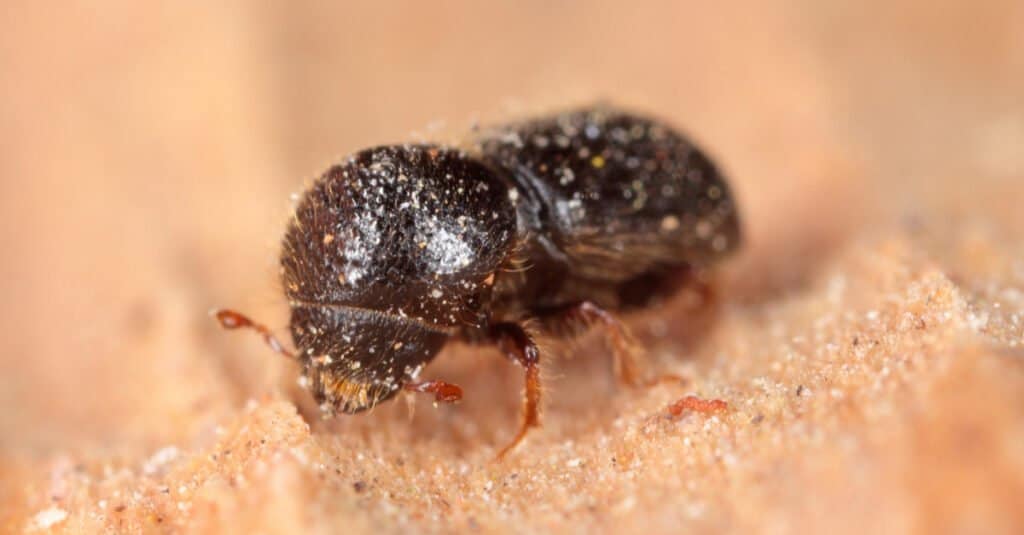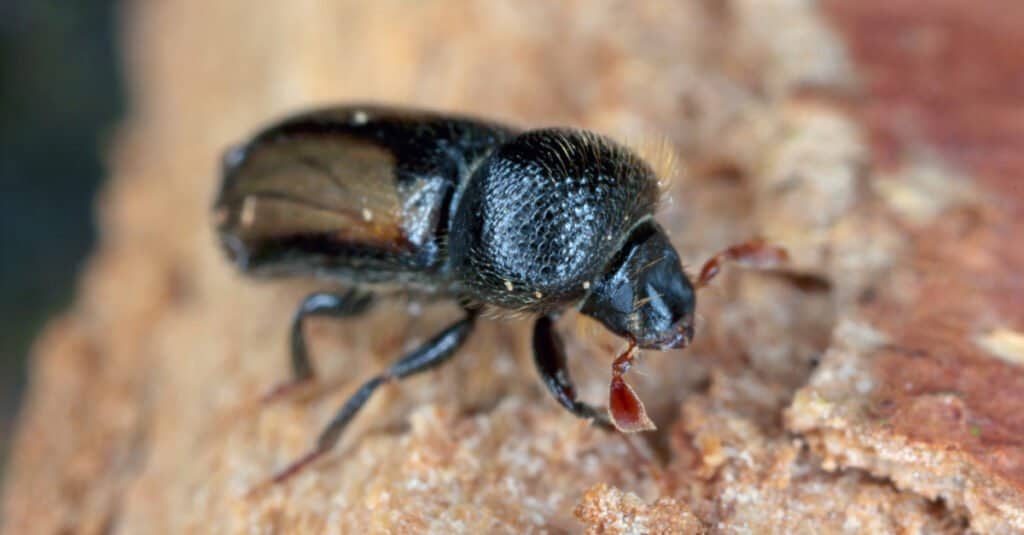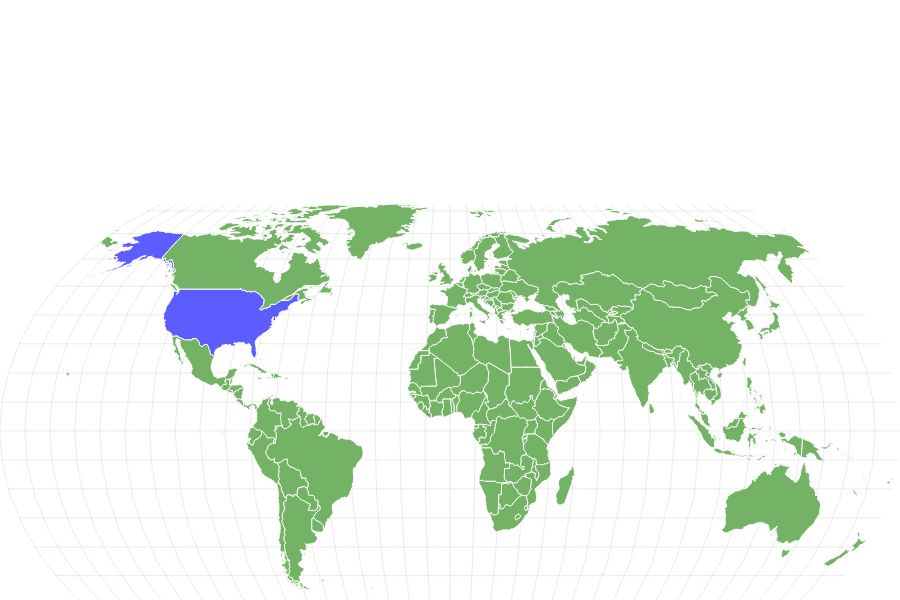Ambrosia Beetle
The ambrosia beetle forms a symbiotic relationship with the ambrosia fungi
Advertisement
Ambrosia Beetle Scientific Classification
Read our Complete Guide to Classification of Animals.
Ambrosia Beetle Conservation Status
Ambrosia Beetle Facts
- Prey
- Fungi
- Name Of Young
- Larvae
- Group Behavior
- Solitary
- Fun Fact
- The ambrosia beetle forms a symbiotic relationship with the ambrosia fungi
- Most Distinctive Feature
- The long oddly shaped shell
- Gestation Period
- one month
- Litter Size
- up to 60 eggs
- Habitat
- Anywhere with hardwood trees, conifers, and woody shrubs
- Predators
- Insects, spiders, reptiles, frogs, mammals, and birds
- Diet
- Omnivore
- Type
- inesct
- Common Name
- Ambrosia Beetle
View all of the Ambrosia Beetle images!

“Some species of ambrosia beetle can fertilize eggs without a male.”
The ambrosia beetle is a loosely related group of weevils/beetles that form a symbiotic relationship with the ambrosia fungi. A symbiotic relationship benefits both parties. The ambrosia beetle can burrow through dead or dying trees.
Once it’s deep within the wood, they will then set up and cultivate a kind of fungal garden to feed their larvae. The beetles benefit by feeding directly on the cultivated fungus.
The fungus benefits by spreading into new habitats, even as it’s fed on by the beetle. This article will cover some interesting facts about the identification, diet, habitat, and life cycle of the ambrosia beetle.
Species, Types, and Scientific Names

The ambrosia beetle is not classified as a specific taxonomical group but rather encompasses over 3,000 species, forming a broad category.
©Tomasz Klejdysz/Shutterstock.com
The ambrosia beetle isn’t considered to be a specific taxonomical group, but rather a loose category that includes more than 3,000 species, spread across several different families, that feed on the ambrosia fungus.
Here are some of the most common species:
- Xyleborus glabratus
- Mountain pine beetle
- Xyleborus dispar
- Tomicus piniperda
- Austroplatypus incompertus
- Spruce wood engraver
- Scolytus schevyrewi
- Large Fruit Bark Beetle
- Hylastes ater
- Cryphalus piceae
- Hylastes cunicularius
- Xyleborus baculum
- Xyleborus africanus
Most species generally belong to the bark beetle family (Scolytinae) or the pinhole borer family (Platypodinae). Both families may have evolved independently from each other. Likewise, the ambrosia fungus isn’t a specific taxonomical group, but merely any species that are fed upon by the ambrosia beetle.
Evolution and Origins
Xleborus glabratus is believed to have been brought into the United States through solid wood packing materials, posing challenges in detecting these cryptic ambrosia beetles in tree or wood product shipments.
The ambrosia beetle belongs to the weevil subfamilies Scolytinae or Platypodinae and is characterized by its obligate association with nutritional fungal symbionts. This obligate symbiosis with fungi is observed in at least 11 separate groups of scolytine and platypodine beetles.
Coleopsis, an ancient beetle species, holds the distinction of being the oldest known beetle, having existed during the earliest Permian period approximately 295 million years ago in Germany. These early beetles, collectively referred to as “Protocoleoptera,” are believed to have been xylophagous, meaning they fed on wood, and had the ability to bore into wood.
Appearance

The ambrosia beetle displays a compact cylindrical body with hues ranging from reddish-brown to black.
©Tomasz Klejdysz/Shutterstock.com
The ambrosia beetle has a small cylindrical body with reddish-brown or black colorations. Their sharp jaws enable them to see through the decaying wood with ease. Some of them have oddly shaped shells that almost look like full plates of armor extending over the head.
The larvae, by contrast, are white legless grubs. They look nothing like the adults. However, identification can be quite difficult from appearance alone, because there is an enormous amount of diversity in this group.
Habitat
The ambrosia beetle is found all over the world, but the highest concentration and greatest diversity of species probably occur in the tropics. They live anywhere with a sufficient number of trees. All species attack dead, dying, and stressed trees (rarely young nursery trees).
A few species from Asia also attack healthy trees, which can become a huge problem if they invade other regions of the globe. Both the granulate ambrosia beetles and the red bay ambrosia beetle may feed on healthy trees.
Diet
The ambrosia beetle can be described as a fungivore. This means it feeds exclusively on fungi.
What eats the ambrosia beetle?
The ambrosia beetle is preyed upon by several different birds, mammals, spiders, insects, and other small predators. The deep “nursery” inside of the tree offers a degree of protection against potential threats, but otherwise, they have few defenses.
What does the ambrosia beetle eat?
The diet of the ambrosia beetle consists exclusively of the ambrosia fungus that it deliberately spreads and cultivates for food. They do not feed on the wood directly; this is in contrast to other wood-boring beetles, which do feed on wood.
Prevention

In numerous instances, the ambrosia beetle is regarded as an environmental asset due to its role in expediting the decomposition process of decaying and dying wood.
©D. Kucharski K. Kucharska/Shutterstock.com
In many cases, the ambrosia beetle is considered to be a net benefit to the environment, because they accelerate the decomposition of dead and dying wood. However, they can do real damage if you intend to use the wood for yourself. Infestations occur much more commonly with logging or agriculture than homes and buildings, but they can attack any lumber that’s recently been cut.
Prevention is usually focused on removing and processing wood quickly before the beetles have an opportunity to attack them. Wood should be properly stored in a safe area where the beetles cannot reach. They also need to be handled with care.
If you have trees on your property, then you should ensure they’re properly cared for and treated with mulching and water. Make sure construction or landscaping hasn’t damaged the root system that can cause stress to a tree. Once the beetle infests a plant, then the best option is to completely replace it.
The tree is unlikely to recover from that point forward because it was probably already dying or damaged in the first place. Insecticides can kill some adult beetles, but it’s difficult to apply the chemicals effectively over the entire tree. Ethanol traps are mostly intended to monitor infestations, not stop them. Fortunately, these beetles tend to do most of the damage in the wild and don’t bother people too much.
View all 194 animals that start with AAmbrosia Beetle FAQs (Frequently Asked Questions)
Are ambrosia beetles dangerous?
Ambrosia beetles pose no danger to people, but they can do enormous damage to already decaying and dead wood.
How many legs does the ambrosia beetle have?
The ambrosia beetle has six legs like most other bugs.
How do you identify the ambrosia beetle?
The ambrosia beetle is characterized by a long, cylindrical body with either brown or red color. It also has hard armored plates covering its upper body. Identification can be a little difficult by appearance alone because they don’t have any distinguishing features that set them apart from other beetles, but the wood-boring behavior is a potential giveaway. Certain signs and symptoms around the tree (which will be explained below) will distinguish them from other burrowing beetles.
How do you get rid of the ambrosia beetle?
The best way to prevent the ambrosia beetle is through the proper management and storage of lumber and wood. If your trees are properly cared for, then they won’t have the opportunity to establish a presence. Insecticides are somewhat effective at killing individual bugs, but these chemicals generally can stop an entire infestation. And traps are mostly intended for monitoring the insect’s presence. If one of your trees has been affected, then it may have to be replaced. Do not count on insecticides or traps to save them.
Why is the redbay ambrosia beetle an invasive species of concern?
The redbay ambrosia is a problematic species because it attacks healthy redbay trees and spreads diseases. Although originally from Asia, it was first detected near Savannah, Georgia in 2002. After the beetle began its infestation, redbay trees declined by some 80% in some areas of Georgia.
How do I know if a tree has ambrosia beetles?
Ambrosia beetles create small round holes in trees, usually measuring no more than a few millimeters in diameter, sometimes surrounded by fungal stains. You may notice frass tubes (the bug’s waste) coming out of the holes as well. Perhaps the most obvious sign is the presence of fine white dust around the base of the tree.
What do ambrosia beetles eat?
Ambrosia beetles feed exclusively on the fungi they carry with them into the host plant of their choosing.
What trees do ambrosia beetles eat?
Ambrosia beetles can attack a wide variety of different trees from around the world. Some species have a specific preference, but many species have a diverse range of different hosts to choose from. Hardwood and conifer trees, woody shrubs, and vines tend to be their favorites. They are attracted to the ethanol given off when the tree is stressed or dying.
Thank you for reading! Have some feedback for us? Contact the AZ Animals editorial team.


















